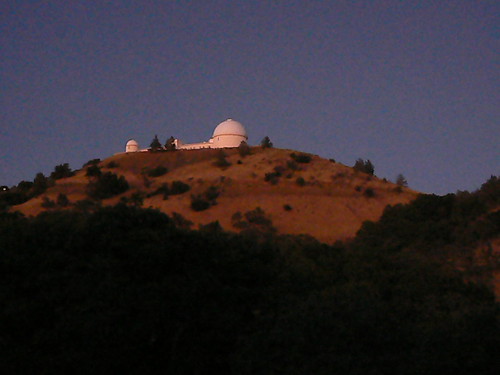James Lick had a problem. He was a very rich man and wanted to be remembered after his death. He thought about building a giant pyramid in downtown San Francisco, he thought about a colossus on the San Francisco coast before a friend talked him into funding the construction of the largest telescope in the world and an astronomy department at the newly formed University of California.
If you are willing to drive 45 minutes up a very windy road from San Jose, California to the top o Mount Hamilton (at 4212 feet the tallest mountain in the San Francisco Bay area) you can see what $750,000 would buy you for a legacy in the 1880s.
Guided Tour
I had the opportunity to take a private guided tour yesterday with one of the 3 resident astronomers at the facility. There are now 9 different domes with different telescopes that have been constructed at the site. The newest two telescopes are robotic telescopes that quickly scan the sky for particular phenomena. One of these is spotting 1-2 supernovae a week (it used to be that the scientific community would find about a dozen in a year). The newest one will look for planets around other suns using a technique pioneered here at the Lick Observatory that has found roughly half of the 300 planets that have been discovered.
Adaptive Optics
Our tour lasted from 6:30pm to about 11pm. We learned about the history of Lick and his observatory. We also learned about a technique that was pioneered there for using adaptive optics in astronomy. In adaptive optics you focus at a bright star close to the object you are trying to observe. Sensitive instruments detect distortions in the atmosphere in front of that bright star and you use that data to deform a reflector to compensate for these distortions. All of this is done by a computer 1000 times a second. Since only 1% of the sky had a bright star near it a technique was invented where a bright laser is shined on sodium molecules in the upper atmosphere that glow creating, in essence, a temporary fake star.
The culmination of the tour is a peak through the old 36 inch telescope that was the worlds largest when it was installed directly over the tomb of James Lick. To make it easy to reach the eye piece the entire floor in the dome can be raised or lowered on hydraulics. This was originally driven by water power supplied by a local windmill. Even today, long after the telescope ceased to be state of the art, this is still a pretty great feat of engineering that does its namesake proud.
Visitor Center
James Lick’s vistor center is open:
- Saturday and Sunday 10 am – 5 pm
- Monday thru Friday 12:30 pm – 5 pm
But to look through the 36 inch telescope yo need to buy a ticket through the Summer Visitors Program.
One Response to “Lick Observatory, San Jose, California”
Leave a Reply
Tags: san francisco bay area, san jose





Dave Tribby
Says:June 16th, 2009 at 10:25 am
I enjoy the Mt. Hamilton web cams, especially time lapse movies from the previous day. Sometimes (particularly during moist months) there are spectacular cloud shows and sunsets. The HamCams are available at http://mthamilton.ucolick.org/hamcam/